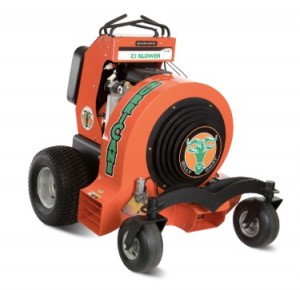 Do you need a stander or a walk-behind blower? Is it worth buying a self-propelled model? What’s the difference between CFM and MPH? Here’s what you need to know to pick the right Billy Goat debris blower for your needs.
Do you need a stander or a walk-behind blower? Is it worth buying a self-propelled model? What’s the difference between CFM and MPH? Here’s what you need to know to pick the right Billy Goat debris blower for your needs.
Power: Volume, Force and Speed
Picking the right blower isn’t just a matter of getting the most power you can afford. Several factors affect performance.
Cubic Feet per Minute: CFM is a measurement of air volume. The higher the volume, the more leaves the machine will clear with each pass.
Velocity: The faster the air exits the blower, the more force it will have. The higher the airspeed, the better the blower will be at moving heavy material like wet, matted leaves.
Speed: The faster the blower moves across the grass, the faster it can move leaves. The average walking speed is 1-2 MPH while pushing a blower, increasing to 2-3 MPH with the help of self-propulsion. The Hurricane stander blowers have a transport speed of 11 MPH, but operating speeds peak at around 5-6 MPH.
Air Direction
Hurricane blowers have three discharge chutes, letting you redirect air around the machine. Once you reach the end of the yard, you can turn around, switch to the chute on the opposite side, and make another pass. Walk behind blowers have a single chute on the left side, so you need to back up for each pass, increasing job time.
All blowers have chutes that adjust up and down. This lets you skim the surface to pull up matted leaves or push against piles to gather them in one spot.
The front vent on stander blowers and discharge elbow on walk behind blowers pushes leaves forward and away from buildings. The elbow is optional on the F6 and comes standard with all other walk behind models.
The F6 is compatible with a 10-foot hose kit. This lets you direct air around bushes and other landscape features to remove hard to reach leaves. This makes it a great compliment to large blowers like the Hurricane standers.
Noise
Billy Goat’s walk behind blowers use a cast composite housing and fan. This reduces turbulence inside the fan chamber, reducing noise. At the operator’s position, noise ranges from 87 dB for the F9 to 97 dB for the F18. This is quiet enough to be well below the 70 dB at 20 feet noise limit mandated by many neighborhoods.
The Z3000 may be more powerful than the X3000, but it also keeps the engine running 800 RPM slower, decreasing noise.
Power
Dealing with thick buildup? Air exits Billy Goat’s walk-behind blowers at speeds nearing 200 MPH, making them the best choice for clearing heavy debris. However, maximum output tops out at only 2,900 CFM for the F18.
Need maximum clearing power? The Hurricane Z3000 moves air at a rate of 8,500 CFM, but the airspeed is only a little over 165 MPH. This makes it the best option for clearing wide areas.
Self-Propulsion
Billy goat offers self-propulsion versions of all of their walk-behind models except the F6. They use a direct drive system, so speed is determined by engine RPM.
Both the X3000 and Z3000 use dual hydraulic motors for maximum maneuverability and fine speed control.
Comfort
The composite housing and fan used in F-series walk behinds reduces weight by 30% compared to steel housing blowers, making them easy to push. The handle has thick padding to limit vibration, and it’s tilted to the left, positioning the operator behind the nozzle for a clear view.
If you’ve ever used a stander mower, you know what to expect from the Hurricane blowers. The operator stands on an isolated, non-skid platform, and can lean against a thick knee pad for stability. The Quad Control handle has two fixed bars surrounding the drive controls, giving the operator several hand position options for reduced fatigue.
Models
F-series walk-behind blowers are named after their approximate engine horsepower.
F6
F601V: 205cc Vanguard Engine
F601X: Briggs & Stratton XR950 Professional engine
F9
F902H: Honda engine
F902S: Subaru engine
F902SPS: Subaru engine, self-propelled
The F902S and F902SPS are being phased out, as Subaru has ended small engine production.
F10
F1002SPV: Vanguard engine
F1002SPV: Vanguard engine, self-propelled
F13
F1302H: Honda engine
F1302SPH: Honda engine, self-propelled
F18
F1802V: Vanguard engine
F1802SPV: Vanguard engine, self-propelled
Hurricane
X3000: 6,500 CFM at 3,200 RPM
Z3000: 8,500 CFM at 2,600 RPM
Both models are powered by a Vanguard V-twin.
Parts Support for Billy Goat Blowers
Picking the right blower can be confusing, but keeping it running is easy. Billygoatparts.com can ship anything you need for your equipment straight to your door, whether you live in the U.S. or Canada. We’re an authorized dealer for Billy Goat and their manufacturing partners including Honda, Vanguard and Hydro-Gear. Our site even has factory diagrams and descriptions so you can see exactly what you’re ordering for your machine.
